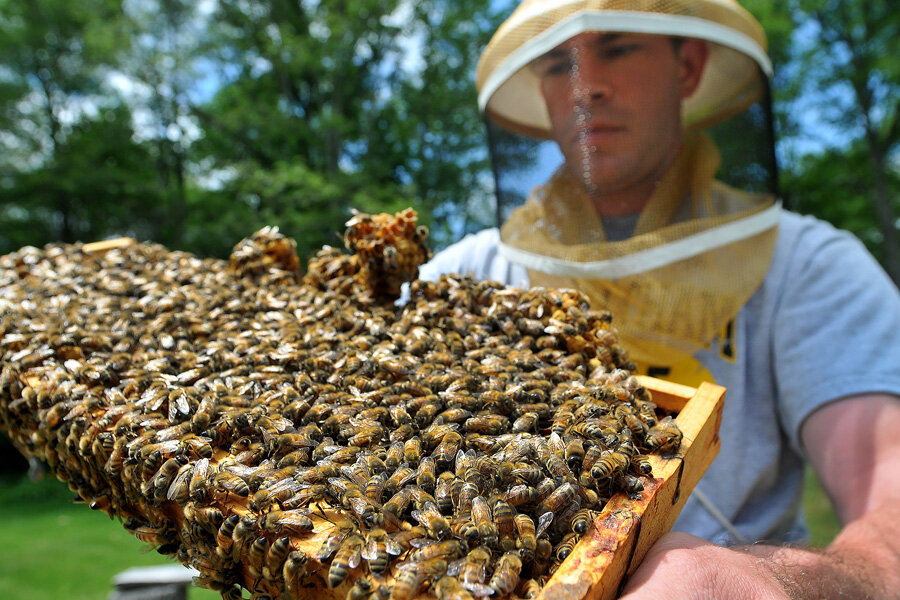How Americans can help protect bees, other pollinators
Loading...
Last month, The White House released a federal strategy plan to protect bees, butterflies, and other pollinators. These species are immensely valuable to our agricultural economy, our own health, as well as our overall environmental health. As discussed in the Food Tank webinar I gave in June (“Pollinators in Peril: Can President Obama Save the Bees?”), while the White House’s pollinator strategy included a number of good ideas, the plan lacks strong, concrete actions, especially those aimed at protecting pollinators from the unique risks posed bee-toxic pesticides like neonicotinoids (neonics).
As the White House moves forward with implementing its National Pollinator Strategy, Center for Food Safety and our allies will continue pressuring the administration to take stronger action by curbing the use of bee-toxic pesticides (and you can, too), but in the meantime, what else can we do to help pollinators?
Here are five key ways to become involved and help pollinators.
- Become a citizen lobbyist. In July 2013, following the largest bumblebee kill on record as a result of a neonicotinoid pesticide application, Representatives John Conyers (D-MI) and Earl Blumenauer (D-OR) introduced the Saving America’s Pollinators Act, which would suspend the use of the four most toxic neonics. Not sure who your elected officials in Congress are? Find out here. You can also sign this petition that delivers your message straight to your Members of Congress, urging them to become a cosponsor of the Saving America’s Pollinators Act.
- Encourage government agencies to act independently. It’s important that we make our voice heard by encouraging government agencies to take action on their own to enact stronger protections for pollinators. A good example of this type of independent agency action is the U.S. Fish and Wildlife Service (FWS), which announced that it will be banning the use of neonicotinoids on all National Wildlife Refuges by January 2016. The FWS is the first government agency to prohibit the use of neonicotinoids, setting an important precedent for other government agencies as they develop their own plans for stronger pollinator protection in the coming months. We should encourage other agencies to amplify their own initiatives for pollinator protection by following in the footsteps of the FWS. I would strongly encourage you to put pressure on the National Parks Service and the U.S. Forest Service to enact a similar prohibition on neonicotinoids and create safe havens for pollinators on their federal lands.
- Join national grassroots campaigns. So far, we’ve delivered more than half a million signatures to EPA Administrator Gina McCarthy, demanding she take strong action to protect pollinators; we’ve delivered more than half a million signatures to the FWS, urging them to protect the monarch butterfly under the Endangered Species Act; and most recently, we protested and delivered more than 4 million signaturesto the White House, telling President Obama to protect pollinators from toxic pesticides. In addition to grassroots action targeting the federal government, we’re also growing a grassroots movement demanding stronger protections for pollinators in the marketplace. There has been a lot of great working happening to pressure Lowes, Home Depot, and other garden stores to offer pollinator-friendly plants that are not-pretreated and contaminated with neonicotinoids (yes, unfortunately, that does happen). We’re also urging them to remove harmful neonicotinoid products from their shelves.
- Activate your community. Dozens of community actions across the country have led to stronger pollinator protections, whether through city ordinances, resolutions, or independent action on behalf of entire neighborhoods. You can call on your city council to ban the use of neonicotinoids on city property, just as residents did in Eugene, Oregon and Seattle, Washington. We’ve also been working with students and administrations at a number of colleges and universities across the country to create “neonic-free” habitats on their campuses. Vermont Law School was the first higher-education campus in the country to receive a neonicotinoid-free designation and we look forward to many more down the road.
- Take action in your own backyard or garden. Avoid using neonics and other harmful pesticide products in your backyard. You can reference this list of bee-toxic pesticides to make sure you’re avoiding the most harmful products (but we’d definitely encourage using no pesticides at all!). It’s important to make sure that any pollinator-friendly plants you purchase have not been treated with neonicotinoids. If you’re not sure which nurseries to purchase from, you can use this list of retailers that have committed to selling plants that are safe for bees. If there are no listed retailers in your area, you can also ask your nursery supplier if their plants were pretreated with neonicotinoids.
You can also plant pollinator-friendly flowers native to your region. This is really important to help pollinators have access to good forage and maintain a healthy diet. You can choose plants for every season: find more on this list from CFS.
Provide nesting sites for wild bees. Just like managed honey bees, wild bees need safe habitats.
Wild bees like to build their homes in the ground, in wood tunnels and in tiny corners of existing structures. You can give them a helping hand by creating structures yourself — from wooden blocks to bamboo bundles — using this guide from the Xerces Society.
Also, if you're able, consider keeping honey bees or supporting your local beekeepers (buy some honey!)
There is so much you can do, but it all starts with becoming educated about bees and then sharing your knowledge. By getting the facts and encouraging others to become involved in efforts to protect bees, we can make a real impact while the White House slowly unrolls and evolves its strategy plan.







